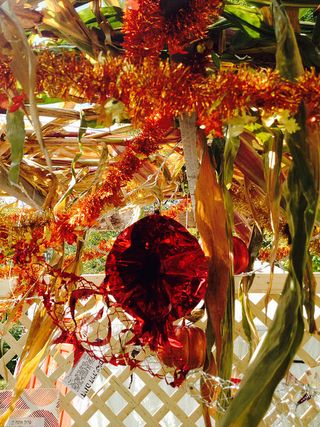It Didn’t Always Rain on Sukkot
September 27, 2018 in Guest Post, Rabbi Greg Harris
This week is the fourth week of the month. For Reflections Off the Bimah, the fourth week features thought leaders drawn from throughout the Jewish world. These special posts give you the opportunity to consider important opinions you may not readily encounter.
This year feels like a Sukkah Wash-Out… but it didn’t always rain. Below is a 2014 Sukkot reflection from Rabbi Rachel Barenblat who has been blogging as the Velveteen Rabbi since 2003. Her blog takes on many current issues. She lives in western Massachusetts.
Letter from the sukkah
October 10, 2014
 On the festival’s first night I carried a tray out to the sukkah bearing dinner, kiddush cups, wine and juice, a lighter for the candle I encased in a many-pointed glass star so that the wind wouldn’t blow it out. Our son complained that he couldn’t see the moon, but we came back outside later when it had just risen — huge and yellow over the dark horizon of the hills — and he jumped up and down with joy.
On the festival’s first night I carried a tray out to the sukkah bearing dinner, kiddush cups, wine and juice, a lighter for the candle I encased in a many-pointed glass star so that the wind wouldn’t blow it out. Our son complained that he couldn’t see the moon, but we came back outside later when it had just risen — huge and yellow over the dark horizon of the hills — and he jumped up and down with joy.
I spent much of the first day of Sukkot bundled up in the sukkah: jeans, socks, fuzzy slippers, a shirt, a sweater, a jacket, a knitted hat and scarf, and fingerless gloves. Above me the cornstalks rustled in the breeze. Occasionally yellow maple leaves drifted down from one of the trees overhead and made their way through the schach of the roof to land on my laptop. I was chilly, but I stayed out for a long time.
Being in a sukkah feels like being indoors and outdoors at the same time. The fresh air says “outdoors;” the feel of roof and walls says “indoors.” But not too indoors. I can see sky through the roof. The usual views of our backyard and the valley are broken into squares by the sukkah’s wooden lattice. All around me, decorations and our son’s apple-themed art hang as though in midair.
Sukkot is so short, in the grand scheme of things. Seven days. I didn’t want to miss it; I didn’t want to waste it sitting indoors at the desk where I sit the whole rest of the year. The commandment is leishev ba-sukkah, “to dwell in the sukkah” — literally, “to sit in the sukkah,” which always makes me think of sitting zazen. The point of sitting in the sukkah is just sitting in the sukkah. Gloves and all.
 I try repeatedly to photograph our sukkah in a way which would show you what it looks like, what it feels like. But as with the panorama of the autumnal Berkshire hills, the pictures of the sukkah don’t capture its reality. Autumn light streaming past golden tinsel garlands and shiny glitter pumpkins, the endless soft rustle of the roof, the little lights which gleam at nightfall. All I can capture are glimpses.
I try repeatedly to photograph our sukkah in a way which would show you what it looks like, what it feels like. But as with the panorama of the autumnal Berkshire hills, the pictures of the sukkah don’t capture its reality. Autumn light streaming past golden tinsel garlands and shiny glitter pumpkins, the endless soft rustle of the roof, the little lights which gleam at nightfall. All I can capture are glimpses.
The sukkah has to be experienced in four dimensions, including time. The sukkah only exists for a short window of time. And yet the sukkah is also a portal in time, a door to every other year when I have sat in a sukkah. The ghosts of ten sukkot are imprinted on this back yard. Surely God, Who inhabits all of space and time simultaneously, can see next year’s sukkah, and the next, and the next…
In the sukkah I can hear crickets chirping. Soon hard frosts will quiet the hillsides. Soon — but not yet. On the first evening of the festival, as we ate dinner in the sukkah, we listened to an invisible neighbor playing “Auld Lang Syne” on clarinet. Our own private Sukkot serenade. The soundscape of the week also includes chipmunks rustling in the hillside’s fallen leaves, and Canada geese calling overhead.
The sukkah, some say, represents the cloud of glory which followed the Israelites in their 40-year wilderness wandering. This is a house of divine presence. The walls and roof may be barely-there, but Shekhinah surrounds me with her embrace. I think of the angel song, that prayer for surrounding our son with wonder, strength, light, comfort, and the presence of Shekhinah all through the night.
Weather will blow in. Eventually the sukkah will come down. Temporariness is an inextricable part of the design. And yet this is where we’re supposed to rejoice. Not despite the leaky roof, short lifespan, short-term design — but with them, in them, through them. Go outside in order to go inside. Through this parody of a roof, recognize the sheltering Presence which curls protectively over us all.